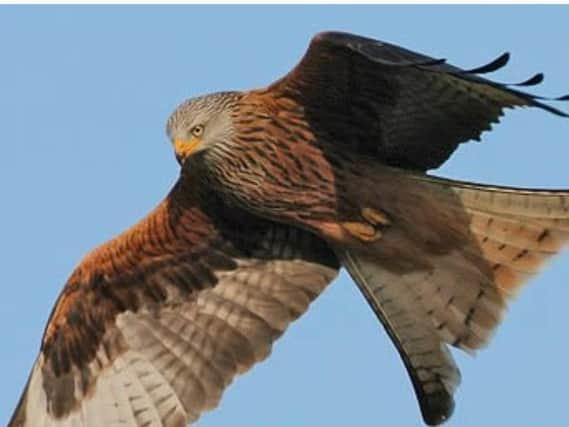The peculiar case of Corby’s dive-bombing birds


Over the past two decades people in Corby have become used to the majestic sight of red kites soaring above them.
Since the beautiful, near-extinct birds were reintroduced into Rockingham Forest in the year 2000, they have become a regular feature of local skies. There are now thought to be 1,600 breeding pairs.
Advertisement
Hide AdAdvertisement
Hide AdKites, which can have a wingspan of 6ft, are said to be gentle birds that eat carrion from roadsides.
But recently, the people of Corby have noticed a change in behaviour from the birds.
The Northants Telegraph has heard three reports in the past two weeks of dive-bombing red kites over the south of the town.
One report came from the Danesholme estate, another from a pedestrian worker on their commute to Oakley Hay and a third from Oakley Vale.
Advertisement
Hide AdAdvertisement
Hide AdBut the Hawk Conservancy Trust said there is no cause for alarm, and that red kites would never harm people.
Mum Amanda Brown, who lives on the Oakley Vale estate, was walking near the shops on Wednesday (June 10) with her 17-year-old daughter and her little pug-cross Maddie.
The trio were watching a red kite above them when it began to circle them. It then dive-bombed them, almost touching the pavement, three times before the were able to run off.
Amanda told the Northants Telegraph: “We were watching it because it was quite low.
Advertisement
Hide AdAdvertisement
Hide Ad”We’re used to seeing red kites here but we’ve noticed them getting lower over the past few weeks. My dog is only the size of a rabbit.
”We were just walking along near the Tesco and noticed it circling and the next thing, it’s diving down at us. It did it three times and I had to pick the dog up and do a runner.
”It certainly looked like it might have been trying to get the dog. People are saying kites don’t do that but it definitely did.
”That said, there was no way it was actually going to be able to pick up the dog.
Advertisement
Hide AdAdvertisement
Hide Ad”As scary as it was, it was fascinating to see it so close. My daughter was very scared and considered jumping over our wall to get away. If I hadn’t picked up the dog it would have come around for another shot.
”I’m a bit worried about letting the dog out in the garden now.”
Last week a worker at the Oakley Hay industrial estate told our reporter that they had been shocked to see a kite swoop down and land on the path in front of them, before swooping up over their head, missing their hair by an inch.
And another on the Danesholme estate said that a bird had repeatedly landed in their garden while their dog was on the lawn, swooping down close to the pet before flying off. The woman said that it looked as though the kite was playing with her dog.
Advertisement
Hide AdAdvertisement
Hide AdBut the Hawk Conservancy Trust says people should not be alarmed. Conservation and research liaison worker Hannah Shaw said that it was ‘wonderful’ that people were seeing more red kites in Corby.
She added that it was tricky to know why the kite might have swooped.
”It’s difficult to speculate without evidence from research,” she said.
”We don’t know how the lockdown might have affected availability of road kill or other carrion.
Advertisement
Hide AdAdvertisement
Hide Ad”Red kites are opportunistic feeders and it is normal behaviour for them to follow livestock, farm vehicles and sometimes people for disturbance of invertebrates and small mammals which they then feed on.
“It may be that the kites have found a new food source in that area, or they simply moving between areas in search of places to forage which are all normal behaviours, especially for younger birds.
”It is possible that people in the area may be feeding kites in their gardens, so they are landing in other gardens in search of food, however Red Kites are not at all dangerous or a threat to people.”
Red Kite Factfile
Red kites were considered to be predatory to game birds during Victorian times so they were killed by gamekeepers in huge numbers.
Advertisement
Hide AdAdvertisement
Hide AdDuring the 1980 there were just a handful of breeding pairs of kites left in Great Britain.
In the late 90s, as part of a national programme, a small number of kites were released into Fineshade Wood and the surrounding parts of Rockingham Forest.
The scheme was a huge success and the birds are now frequently seen in the skies above the whole region.
New colonies of the birds have been bred across the country from chicks born at Rockingham Forest.
Advertisement
Hide AdAdvertisement
Hide AdIt’s now estimated there are 1,600 breeding pairs across the whole country.
Interfering with or killing the birds is illegal, but that hasn’t stopped some people trying to shoot them. They are also at threat of eating poison laid to kill foxes or crows.
The birds live for about ten years although the oldest known kite was 26-years-old